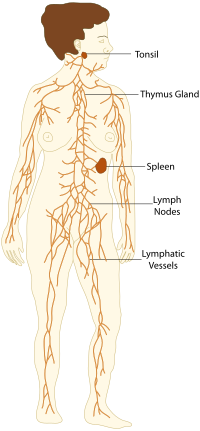Exercise and metabolic disease/BCRL/Pathophysiology
Lymphoedema is the accumulation of excess fluid in any part of the body that has experienced damage to the lymphatics. [1] One of the lymph systems primary functions is to transport proteins such as cancer cells, bacteria and viruses. It also removes excess fat, water, foreign material and cellular debris from the tissues of the body. [2]

The type of molecules that enter the lymph system differ from those collected in veins. Openings to the lymph system are larger than the opening of the veins, therefore larger molecules such as cancer] cells and viruses, can only be removed from the tissues via the lymphatic system. The molecules enter the initial openings of the lymphatic system, fluid then moves through the lymph vessels until it reaches the lymph nodes. Lymph nodes trap toxins and harmful materials which stop them from entering the blood.
There are white bood cells located in the lymph nodes which form antigens to the bacteria that has been traped in the node triggering an immune response. The immune response happens in the specific tissue that the lymph node services, preventing the development of infections in that area. If lymph nodes are damaged or removed, the immune response is damaged as is the ability for it to remove large particles and eccess fluids from the tissue in the area. If only one lymph node is removed the damage is only very small, the more nodes that are removed the more impact it has on the bodies ability to deal with inflammation, injury and infections.
More information can be found on Wikipedia's lymphatic system page.
References
<references>